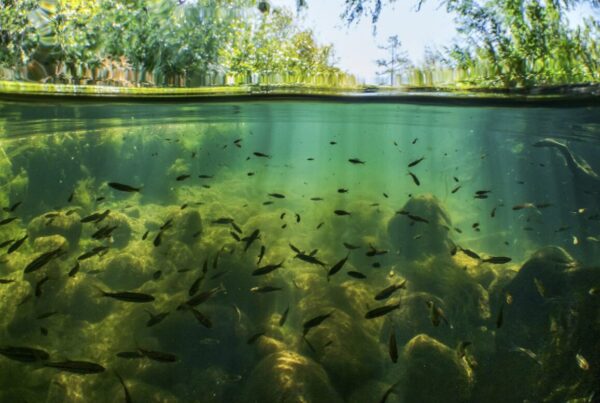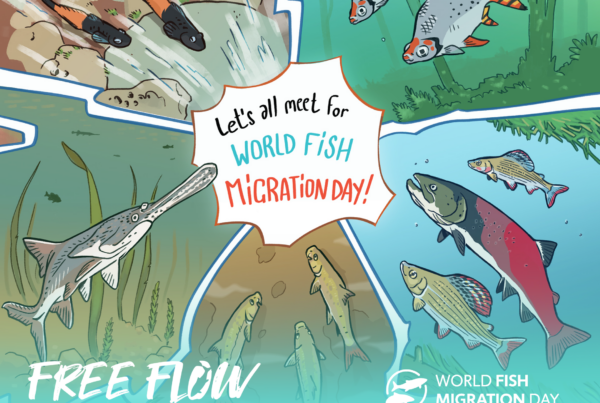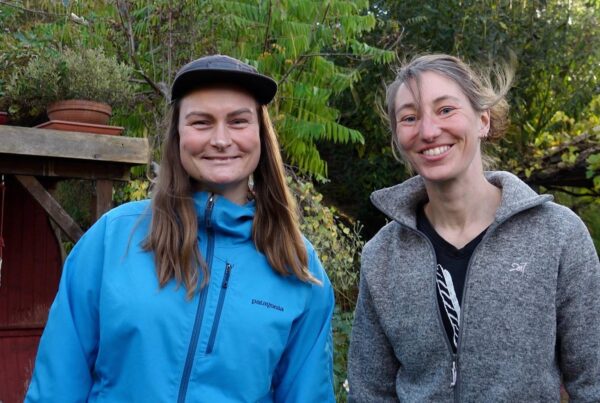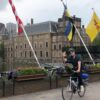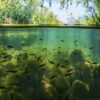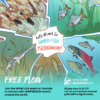Meet Bob Kreiken – he feels strong for sturgeons!
Bob Kreiken is a PhD researcher in international biodiversity policies at Delft University of Technology in the Netherlands. As a child, he and his friends exchanged fish between their aquaria. A true nature, history and adventure enthusiast he now combines his passions for and experience in science to show people the beauty and tell the history of rivers and sturgeons.
Today, he embarks on a two-month expedition of 4.000 kilometers across Europe, along the Rhine by bicycle and Danube by kayak, from the North to the Black Sea to raise awareness and €50.000 for the World Wide Fund for Nature to fund sturgeon conservation projects.
We had the pleasure to interview Bob and know more about his mission.
What inspired you to start this expedition?
[Bob] Traveling down the Danube has been a long-held dream of mine! It is a unique river with a rich ecology and cultural and military history. It was only later, during my studies in forest and nature conservation, that I discovered that the Danube is a sturgeon diversity hotspot. I was amazed that so few people were talking about this intriguing and critically endangered species.
Animals that outlived the dinosaurs are worth saving, for they might outlive us humans! I wanted to do something to get people talking to counter the process of societal extinction, a concept proposed by scientists to describe the loss of history and memory of and cultural connections with species.

Why is it called Strong for Sturgeons?
[Bob] Sturgeons being very big, long and old got everything to be one of Europe’s iconic species. To migrate up and down two iconic European rivers, I must get as strong as a sturgeon. So, knowing people’s interest in athletic adventures, I decided to combine the journey with a crowdfunding and included a cycling stage along the Rhine to really capture the cross-Europe idea in the campaign.
After a bit of playing with Danube Dinosaur I finally decided on ‘Strong for Sturgeons’ to capture the campaign’s message. I hope to inspire cyclists and water sport enthusiasts to do more for nature they enjoy daily.
What challenges do sturgeons face in the Danube River basin?
[Bob] Sturgeons face a number of threats. The biggest threat is habitat degradation, which is caused by dam-building in the Danube and its tributaries, gravel mining, and chemical (and possibly noise) pollution. These factors mean sturgeons have fewer breeding and feeding grounds with lower quality. While obsolete dams may be removed, many still perform security or hydroenergy functions. Such dams need fish traps or migration channels to be dug. On top of that, illegal poaching and bycatch put further pressure on sturgeon populations, especially as sturgeons only breed very late in life.
Although countries have outlawed sturgeon fishing due to the loss of fishing communities, the astronomic price of caviar still invites illegal caviar to enter the market. Fishermen are motivated to put back sturgeons they caught in their nets, and thereby make opportunity costs, but this requires monitoring, trust and incentives, which can be provided by governments and nature agencies. Restocking also comes with its challenges as each of the six Danube sturgeons shows unique behaviour.

Tell us more about your expedition. What are the activities and goals of your journey along the Rhine and Danube?
[Bob] I start on the 3rd of July from Katwijk aan Zee with a group of friends towards Leiden, in The Netherlands, where I did my Bachelor’s. I pass the Dutch WWF headquarters, in Zeist, and then meet volunteers, in Wageningen, where I did my Masters. From then on, I jolt past the beautiful German cities along the Rhine and go to company InnovaSea in Cologne. This company is lending me a hydrophone radar which I attach to my kayak to pick up sturgeon signals.
After a long stretch I enter the French-German border and visit the EU parliament in Strasbourg. Cycling around the Black Forest and travelling through Bazel, I then proceed to Donaueschingen, the unofficial source of the Danube, and Ulm. In Ulm the Danube becomes navigable and people in the past used wooden boats called ‘Ulm boxes’ to travel downstream. My kind father drives my foldable kayak and gear to Ulm for the kayaking.
After some great places, like the Kelheim gorge, the oldest brewery in the world, and the three-river confluence in Passau, my first stop is in Vienna. Here I have an event planned with the LIFEBoat4Sturgeon project which will restock the Danube with four sturgeon species (Beluga, Russian, Stellate and Sterlet). We will visit the hatchery and SUP across the river towards a sturgeon graffiti wall where others from the International Commission for the Protection of the Danube River, World Fish Migration Foundation and WWF-Austria will be (hopefully).
Two days later, I will be escorted by WWF-Slovakia in the famous Slovakian Danube floodplains. Thereafter, I have a long journey ahead with a long rest weekend in Budapest coinciding with Sziget festival. Still in doubt whether I should visit!
My other confirmed meet-up is in Belene with WWF-Bulgaria where I hope to talk with fishermen about the sturgeons.
Sometime in early September, I finish in St George of the Danube Delta, hoping to speak to ecologists there. This is also the time when the pelicans start migrating and it will be time for me to travel back. I depart from Constanta back to the Netherlands with sore muscles but fulfilled soul. I will take videos along the route and compile them into a short documentary.
What do you hope to achieve by the end of this journey?
[Bob] Having safely and successfully completed the most challenging and exciting adventure of my life with a positive effect on the environment! I hope to have gotten a good insight in how the conservation sector operates internationally. Apart from the fundraising, which will directly benefit sturgeon reintroduction, I sincerely hope most to get people to start talking about the sturgeon, which in the long term would translate to more support for their reintroduction across Europe. This will be a process of dozens if not hundreds of years.

How can local communities and individuals support your mission and contribute to the conservation of sturgeons?
[Bob] Start talking about sturgeons and how you can support the nearest reintroduction efforts. Teach kids about this species and let them reimagine them in the rivers through stories. Everyone is free to use the Strong for Sturgeons slogan. People are also very welcome to sing along the ‘Like a Sturgeon’ cover of Madonna. Donating to my fundraising link Sterk voor Steuren (wwf.nl) is also a very direct contribution, but unfortunately, my donation link (that is linked to the Dutch WWF office) is not compatible with everyone’s payment system. Therefore, I recommend committed people to directly get in touch with LIFEBoat4Sturgeon to adopt a sturgeon Adopt a sturgeon FORMULAR – LIFE-Boat4Sturgeon (lb4sturgeon.eu).



